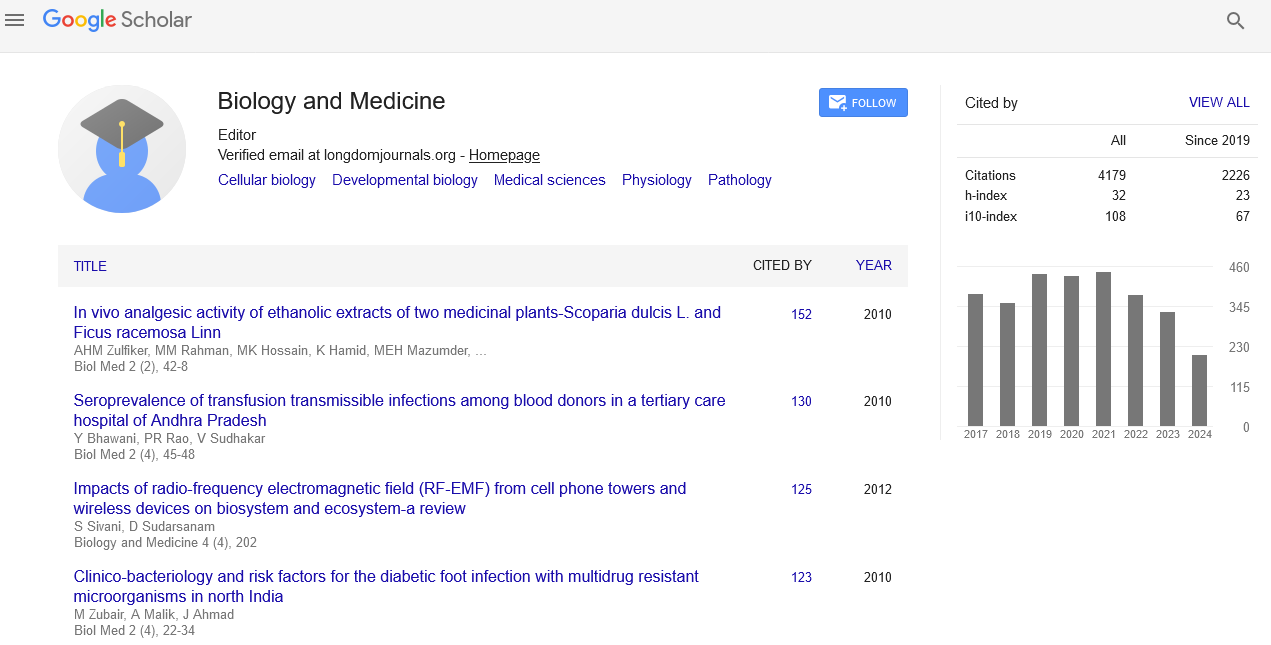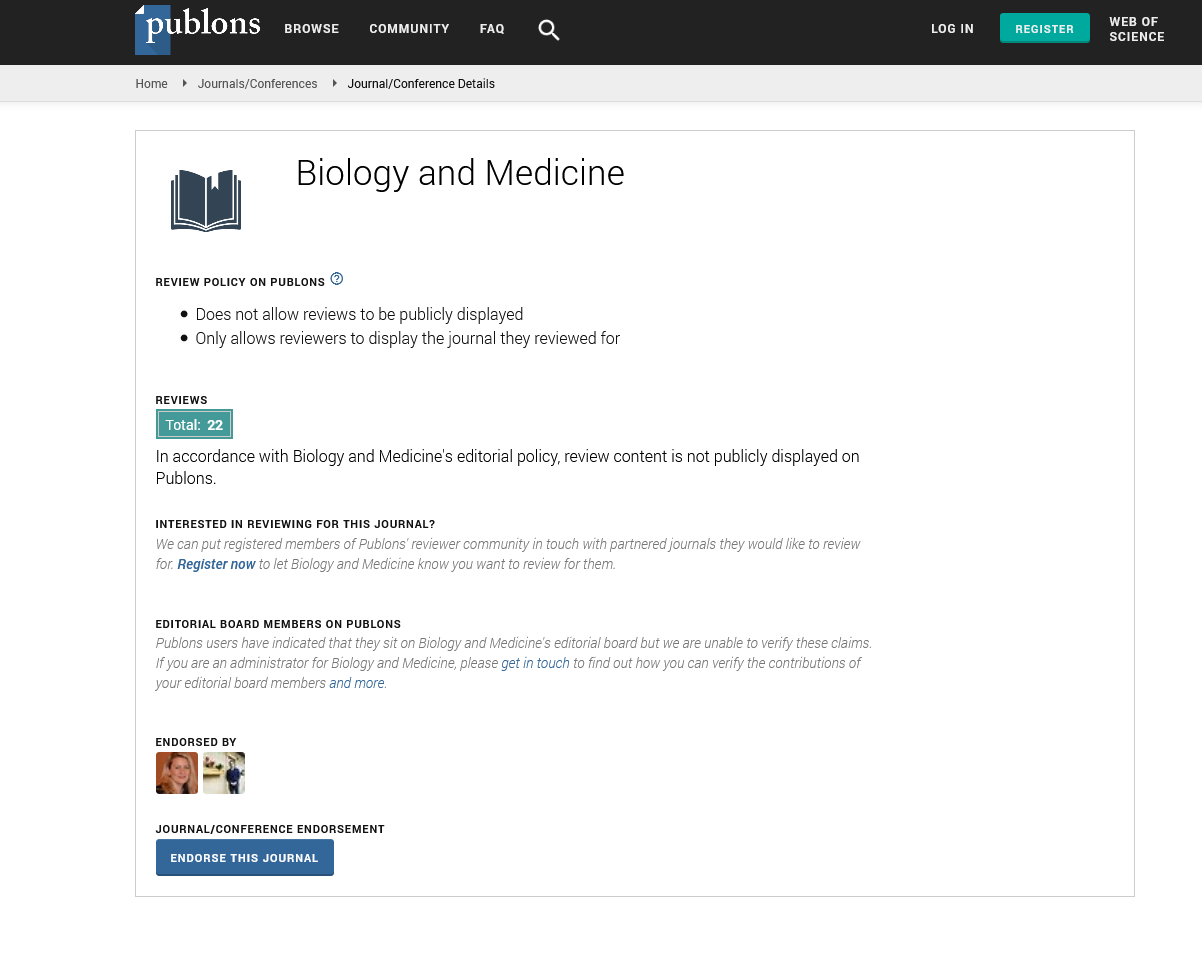Indexed In
- Open J Gate
- Genamics JournalSeek
- CiteFactor
- Cosmos IF
- Scimago
- Ulrich's Periodicals Directory
- Electronic Journals Library
- RefSeek
- Hamdard University
- EBSCO A-Z
- Directory of Abstract Indexing for Journals
- OCLC- WorldCat
- Proquest Summons
- Scholarsteer
- ROAD
- Virtual Library of Biology (vifabio)
- Publons
- Geneva Foundation for Medical Education and Research
- Google Scholar
Useful Links
Share This Page
Journal Flyer

Open Access Journals
- Agri and Aquaculture
- Biochemistry
- Bioinformatics & Systems Biology
- Business & Management
- Chemistry
- Clinical Sciences
- Engineering
- Food & Nutrition
- General Science
- Genetics & Molecular Biology
- Immunology & Microbiology
- Medical Sciences
- Neuroscience & Psychology
- Nursing & Health Care
- Pharmaceutical Sciences
Commentary - (2025) Volume 17, Issue 3
Medical Applications of CRISPR Beyond Gene Editing
Zachary Mendez*Received: 12-Feb-2025, Manuscript No. BLM-25-28811 ; Editor assigned: 14-Feb-2025, Pre QC No. BLM-25-28811 (PQ); Reviewed: 28-Feb-2025, QC No. BLM-25-28811 ; Revised: 07-Mar-2025, Manuscript No. BLM-25-28811 (R); Published: 14-Mar-2025, DOI: 10.35248/0974-8369.25.17.767
Description
Since its discovery as a genetic defense mechanism in bacteria, the CRISPR-Cas9 system has emerged as a groundbreaking tool for genome editing. The ability to make precise changes to DNA has made CRISPR a cornerstone of genetic research and a transformative technology for biotechnology and medicine. However, the potential of CRISPR extends far beyond its initial applications in gene editing.
Recent innovations in CRISPR technology have led to a wide range of non-editing applications that promise to revolutionize medical diagnostics, therapeutics, and functional genomics. These applications leverage the CRISPR system's ability to interact with DNA, RNA, and proteins, providing new avenues for precise, targeted therapies and personalized medicine. One of the most exciting applications of CRISPR technology is in the field of gene regulation, which goes beyond simply altering the genetic code. CRISPR interference (CRISPRi) and CRISPR activation (CRISPRa) allow scientists to silence or activate genes without permanently changing the DNA sequence.
CRISPRi and CRISPRa
CRISPRi utilizes a catalytically dead version of the Cas9 protein (dCas9) that can bind to a specific gene but does not cut the DNA. By fusing dCas9 with repressor domains, researchers can block transcription and prevent the gene from being expressed. This technique has broad applications for studying gene function and the development of therapeutic strategies for diseases where gene silencing is needed, such as cancer, viral infections, and autoimmune diseases. On the other hand, CRISPRa works by fusing dCas9 to an activator domain, which enhances the expression of a specific gene. This can be used to boost the expression of therapeutic genes or to compensate for defective genes in diseases like muscular dystrophy or cystic fibrosis.
Beyond gene editing, CRISPR has shown tremendous potential in the field of diagnostics. CRISPR-based diagnostic platforms are being developed to detect specific genetic sequences with high sensitivity and accuracy. These diagnostic tests use CRISPR proteins like C2c2, a Class 2 CRISPR-associated protein, to recognize and bind to RNA sequences in target pathogens. One of the most notable examples is the SHERLOCK (Specific High-sensitivity Enzymatic Reporter UnLOCKing) method, which uses the CRISPR-Cas13 system to detect specific RNA sequences. This system can be used to detect pathogens, including viruses such as Zika, dengue, and SARS-CoV-2, with high specificity and sensitivity. Additionally, CRISPR-based diagnostics could be applied to genetic screening and early detection of diseases like cancer or genetic disorders.
Another innovative application of CRISPR is its use in targeted drug delivery. The CRISPR-Cas9 system can be harnessed to direct drugs to specific tissues or cells with high precision, reducing off-target effects and improving the effectiveness of treatments. This approach has the potential to enhance personalized medicine by ensuring that therapeutic agents are delivered specifically to the sites of disease. One example is the use of CRISPR to modify immune cells for cancer immunotherapy. By genetically modifying T-cells with CRISPR, scientists can enhance their ability to target and attack cancer cells while minimizing damage to healthy tissue. Additionally, gene-editing CRISPR technology can be used to improve the ability of antibodies or nanoparticles to specifically target tumor cells or other diseased tissues, providing a safer and more efficient therapeutic option.
CRISPR technology is also a powerful tool for functional genomics—the study of how genes function and contribute to biological processes. The ability to create genetic knockouts or modifications using CRISPR allows researchers to investigate the function of individual genes in living organisms. This is especially important for understanding complex diseases like neurodegenerative disorders, cancer, and heart disease. By systematically disrupting genes and observing the effects, scientists can identify critical genes and pathways involved in disease development. Additionally, CRISPR is used to model human diseases in animal models, providing a deeper understanding of the molecular mechanisms that drive disease progression.
Conclusion
CRISPR technology has far-reaching potential beyond gene editing. Its applications in gene regulation, diagnostics, drug delivery, and functional genomics are just beginning to be explored, but they promise to revolutionize medical practice in ways previously unimaginable. While challenges remain in terms of delivery, precision, and ethical considerations, the nonediting applications of CRISPR offer exciting new avenues for treating diseases, improving diagnostics, and understanding the complexities of human biology.
Citation: Mendez Z (2025). Medical Applications of CRISPR Beyond Gene Editing. Bio Med. 17:783.
Copyright: © 2025 Mendez Z. This is an open-access article distributed under the terms of the Creative Commons Attribution License, which permits unrestricted use, distribution and reproduction in any medium, provided the original author and source are credited


